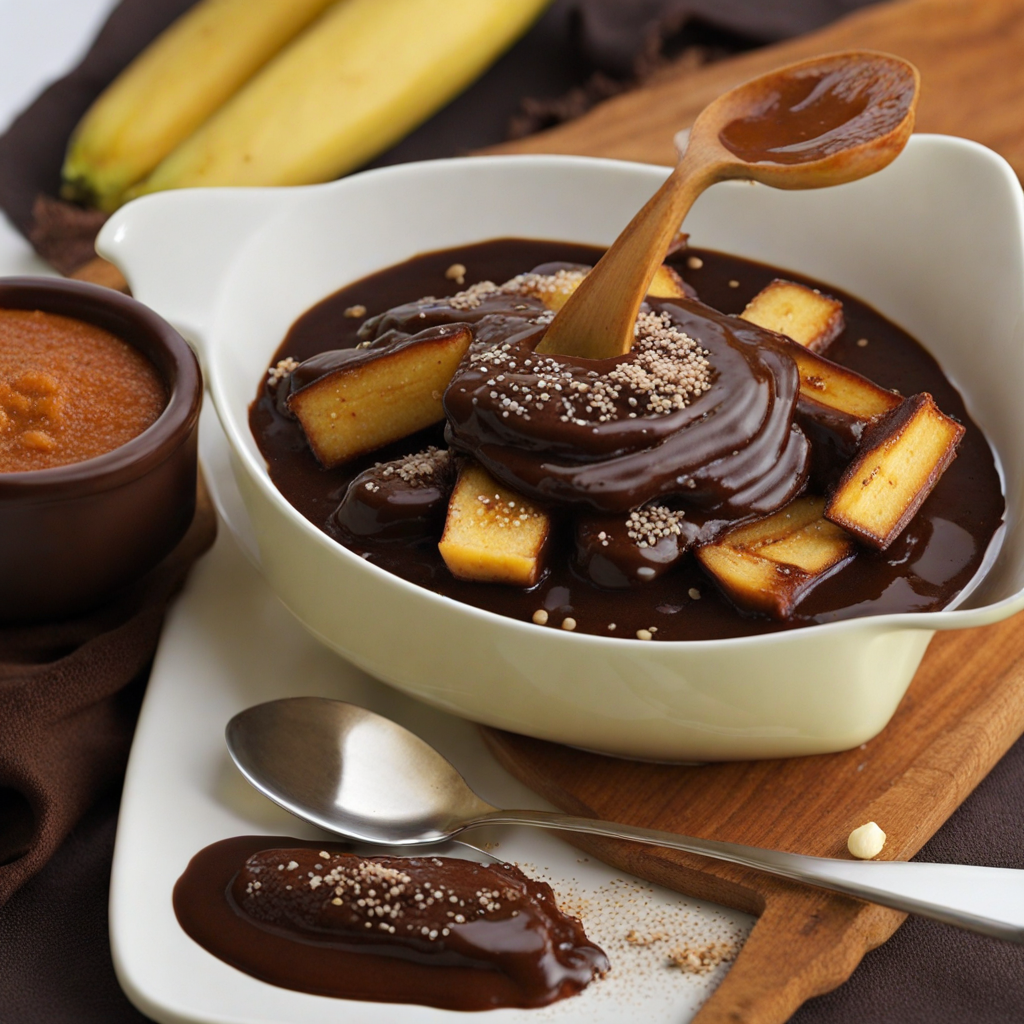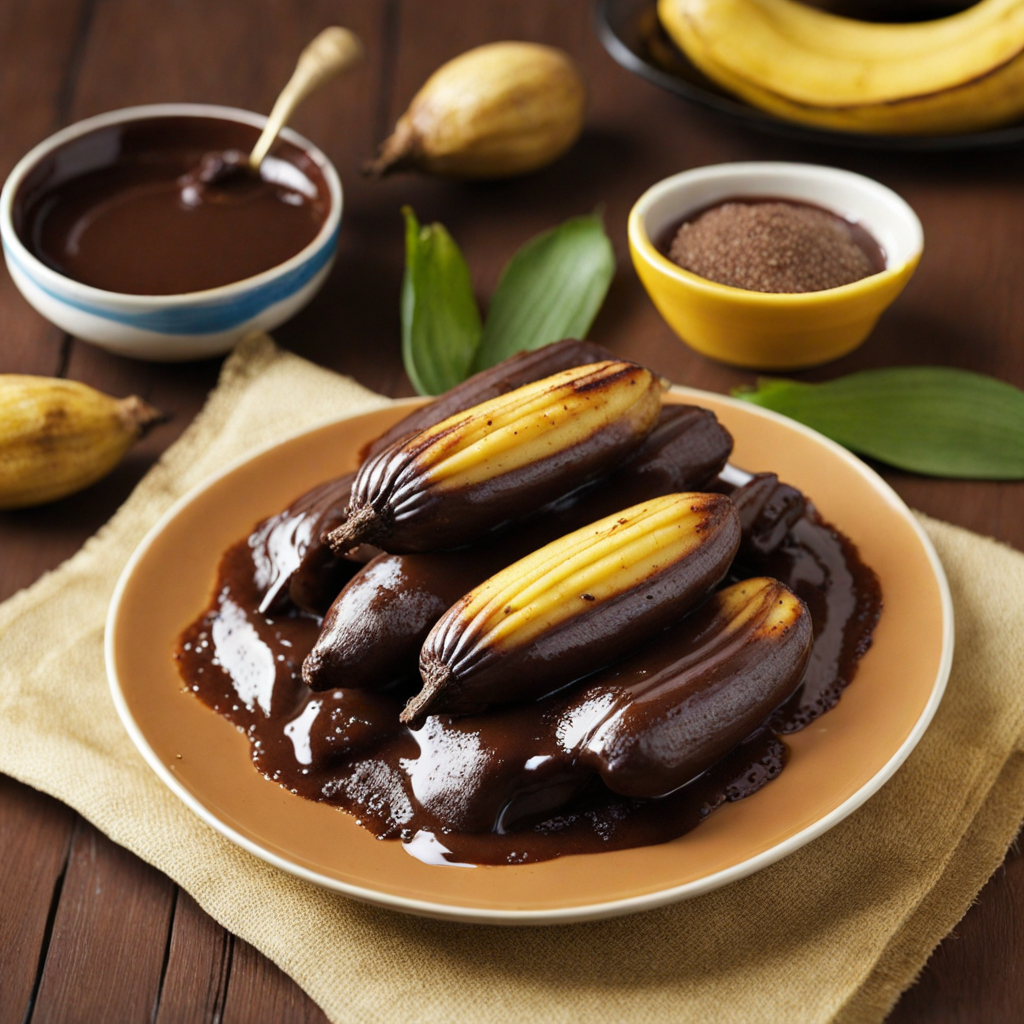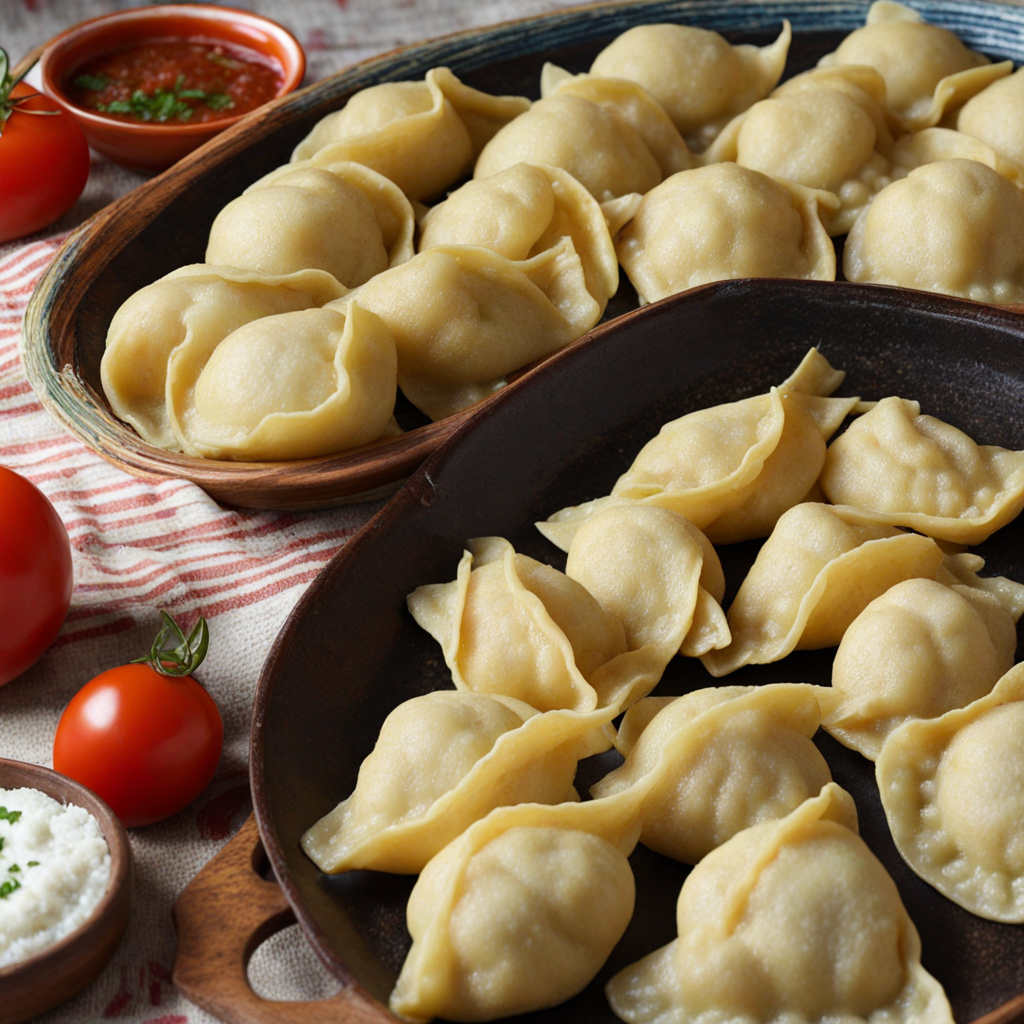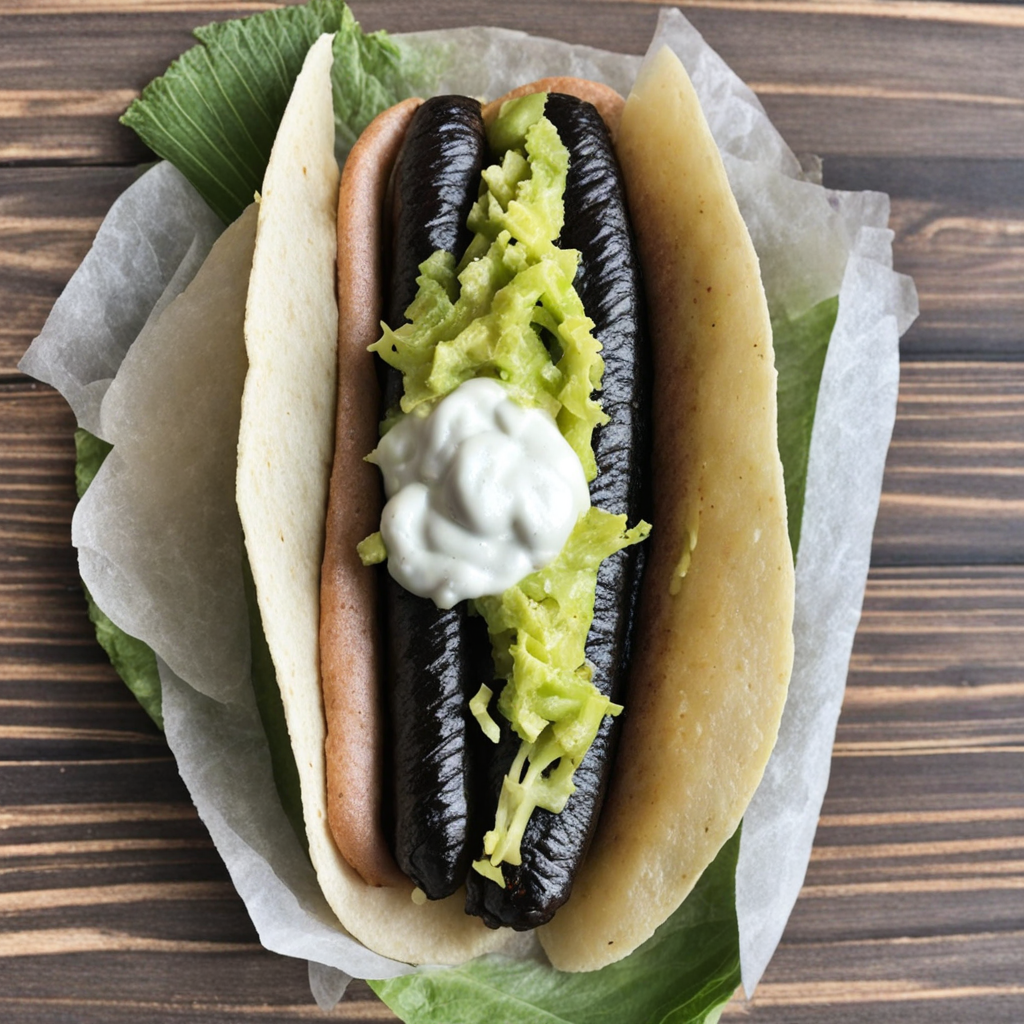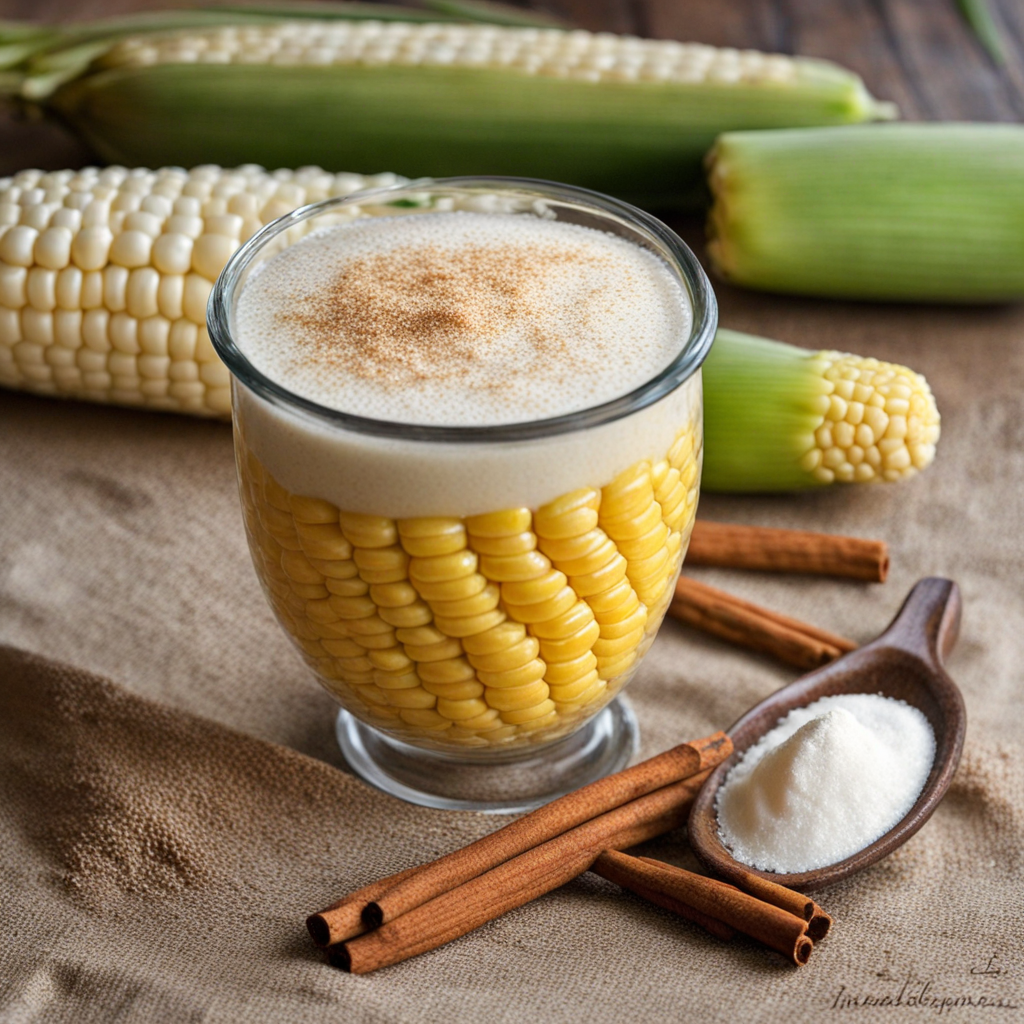Platanos en Mole
Platanos en Mole is a delightful Guatemalan dish that beautifully combines the sweet and savory elements of ripe plantains with a rich, complex mole sauce. The dish begins with the selection of perfectly ripe plantains, which are peeled and sliced, then sautéed or fried until they achieve a golden-brown exterior while remaining tender and sweet on the inside. The natural sweetness of the plantains serves as a perfect canvas for the bold flavors of the mole, making each bite a harmonious blend of taste and texture that showcases the essence of Guatemalan cuisine. The mole sauce itself is a labor of love, typically made from a blend of roasted ingredients such as chili peppers, nuts, seeds, and spices, all simmered together to create a luscious, velvety sauce. This sauce can vary in flavor and heat, depending on the specific chilies used and the preparation method, offering a depth that can range from smoky and rich to mildly spicy. The combination of the sweet plantains with the savory, often slightly spicy mole results in a dish that is both comforting and exciting, appealing to a wide range of palates. Served warm, Platanos en Mole can be enjoyed as a main course or a side dish, often accompanied by rice or tortillas to soak up the flavorful sauce. This dish embodies the heart of Guatemalan cooking—simple ingredients elevated through thoughtful preparation, resulting in a meal that is not only satisfying but also a true representation of the country’s culinary heritage. Whether you're discovering it for the first time or revisiting a beloved favorite, Platanos en Mole promises to deliver a memorable taste experience that showcases the vibrant flavors of Guatemala.
How It Became This Dish
The History of Plátanos en Mole: A Guatemalan Culinary Treasure Origins and Ingredients Plátanos en mole, or bananas in mole sauce, is a dish that encapsulates the rich culinary heritage of Guatemala, intertwining indigenous traditions with colonial influences. The word "plátano" refers to the cooking banana, a staple in many Central American diets, while "mole" denotes a complex sauce that has its roots in pre-Columbian Mesoamerica. Although mole is often associated with Mexican cuisine, its Guatemalan variations are distinct and deeply rooted in local customs. The origins of plátanos en mole can be traced back to the pre-Columbian era. The banana, originally from Southeast Asia, was brought to the Americas by early explorers and quickly became a fundamental part of the Guatemalan diet. Indigenous peoples cultivated various types of bananas, particularly the plantain, which was favored for its versatility and ability to thrive in the region's tropical climate. Mole, on the other hand, has a more intricate lineage. The word itself derives from the Nahuatl term "molli," which means sauce or mixture. The earliest forms of mole were simple salsas made with local ingredients such as tomatoes, peppers, and spices. Over the centuries, as trade routes expanded and European ingredients became available, the mole evolved into more elaborate concoctions. In Guatemala, mole is often made with a blend of spices, nuts, seeds, and sometimes chocolate, reflecting the country’s rich biodiversity and cultural syncretism. Cultural Significance Plátanos en mole is more than just a dish; it is a cultural expression that embodies the fusion of heritage and identity in Guatemala. The combination of cooking bananas and mole sauce represents the agricultural bounty of the region, as both ingredients are widely grown and cherished. The dish is often prepared for family gatherings, celebrations, and religious festivities, making it a significant part of communal life. In Guatemalan culture, food serves as a vessel for storytelling and tradition. Preparing and sharing plátanos en mole often involves multi-generational participation, where recipes are passed down from mothers to daughters, preserving not only the culinary techniques but also the cultural narratives associated with them. The act of cooking becomes an opportunity to connect with one's roots, honoring ancestors and reinforcing family bonds. Moreover, plátanos en mole exemplifies the resilience of Guatemalan cuisine in adapting to historical changes. The Spanish colonization introduced new ingredients such as garlic, onions, and various spices, which melded with indigenous cooking methods. The resulting dishes, including plátanos en mole, reflect this hybridization, symbolizing how cultures can coalesce to create something uniquely beautiful. Development Over Time As Guatemala moved through the centuries, the culinary landscape continued to evolve, shaped by socio-political changes, globalization, and migration. The 20th century saw a significant shift in the way traditional foods were prepared and consumed. Urbanization led to the rise of street food vendors and restaurants that adapted traditional recipes to cater to a modern palate, while still retaining the essence of the original flavors. In contemporary Guatemala, plátanos en mole can be found in both casual eateries and upscale restaurants, reflecting its versatility and enduring appeal. Chefs increasingly experiment with the dish, incorporating local ingredients like avocados, fresh herbs, and artisan cheeses to enhance the traditional recipe. The addition of these elements not only modernizes the dish but also highlights the abundance of local produce, showcasing the vibrant culinary scene in Guatemala. Furthermore, as the global interest in authentic and sustainable food experiences grows, plátanos en mole has gained recognition beyond Guatemala's borders. Travelers and food enthusiasts are drawn to the dish for its unique combination of flavors and its cultural significance. As a result, it has become a symbol of Guatemalan cuisine in the international culinary arena, inspiring chefs worldwide to explore its flavors and techniques. Nutritional Aspects and Variations From a nutritional standpoint, plátanos en mole is a well-rounded dish. The cooking bananas provide a good source of carbohydrates, vitamins, and minerals, while the mole sauce, rich in nuts and seeds, adds healthy fats and protein. The combination results in a satisfying and nourishing meal that can be enjoyed in various forms. There are numerous variations of plátanos en mole across different regions of Guatemala. Some versions may feature additional ingredients such as shredded chicken, beef, or even seafood, reflecting local preferences and available resources. In some households, the mole sauce might be made spicier or sweeter, allowing for a personal touch that showcases individual family traditions. Conclusion Plátanos en mole stands as a testament to Guatemala's rich culinary history, embodying the intersection of indigenous and colonial influences that have shaped the nation's food culture. This dish not only offers a tantalizing flavor experience but also serves as a reminder of the stories, traditions, and values that are passed down through generations. As Guatemala continues to navigate the complexities of modernity and globalization, plátanos en mole remains a cherished dish that encapsulates the spirit of resilience, adaptation, and community. It invites both locals and visitors alike to savor its unique flavors while appreciating the deep cultural significance that lies beneath each bite. In celebrating plátanos en mole, we celebrate Guatemala—a land rich in history, culture, and culinary artistry.
You may like
Discover local flavors from Guatemala


